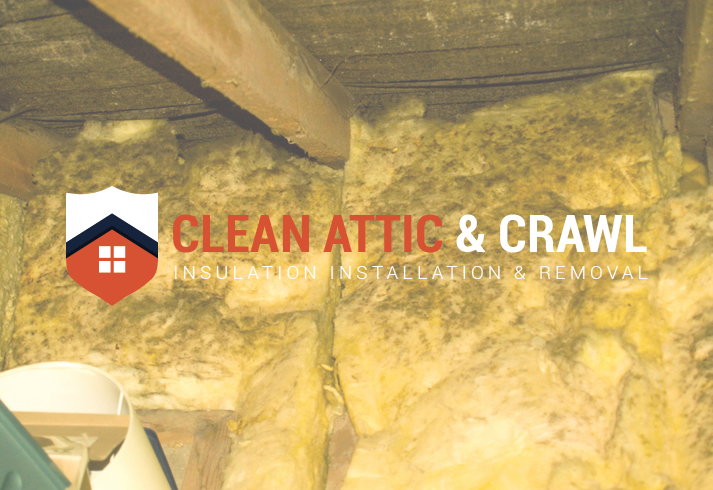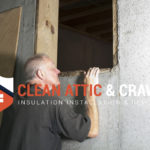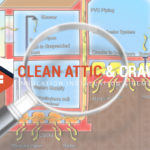Easy Guide to Fixing Wet Insulation
If you live in areas which experience lots of rainfall, you’ve probably got an issue with wet insulation. Are you struggling to find the right method to fix your wet insulation? If the answer is yes, then you may want to use this easy guide to fixing wet insulation to solve your problem.

When Your Spray Foam Insulation is Wet
If your spray foam closed cell insulation is wet you don’t need to worry. Spray foam closed cell insulation comes with an air-tight sealant and a moisture barricade. Have you discovered water in your spray foam insulation?
If you have, then perhaps you’ve got a leak in your home. The best thing is that the water will hardly penetrate inside the insulation. Often, the water will easily evaporate from the surface. Where possible, you can simply wipe the excess water using a towel to safeguard the absorbent and wooden areas of your home.
- HOW TO KILL MOLD IN YOUR CRAWL SPACE FAST
- I FOUND MOLD IN MY ATTIC! WHAT DO I DO?
- EASY GUIDE TO BUDGETING FOR ATTIC CLEANING COSTS
When Your Fiberglass Insulation is Wet
Loose fill insulation and fiberglass batts provide your home with an effective cost-saving solution to air conditioning and high heating expenses. If you want to achieve the best results, ensure that your fiberglass is installed in the dry space along your attic joists and or walls. Remember, when your fiberglass is wet, you’ll not enjoy an effective performance. The good this is that this problem doesn’t last. Once the fiberglass dries, you can be sure that it’ll function effectively.
How Can You Keep Your Fiberglass Insulation Dry?
What happens when your fiberglass becomes wet? Water droplets will replace the air available in the space in between the thin glass fibers which cut down the material’s acoustic and thermal insulating capability.
In order to ensure that this doesn’t happen, you should seal and caulk all gaps around the external wood sheathing in your home which may let in water in the event of a heavy downpour. While fiberglass is already treated using a mildewcide, mold is likely to form on mineral deposits and dirt remnants once the moisture evaporates.
How to Manage a Wet Fiberglass Insulation
The fiberglass in your attic or wall cavity may get wet due to a burst pipe or a leaky roof. If this happens, it’ll lose its insulating potency. The good news is that it’ll regain its effectiveness after the insulation dries up. One thing you should beware of is that when your loose fill insulation or fiberglass batts are flooded with dirty water, they will soak entirely which will join the fibers together and create clumps. Once the fiberglass is contaminated or compressed, then your fiberglass will seize to be effective and this is where you’ll need to replace it.
What Steps Should You Take?
Where possible, try to dry out your insulation. If it’s located in your crawl space or an attic, running a fan or a dehumidifier can help in drying the area. Where possible, hoist the affected batts and keep them in a dry and warm area to dry them out.
Remember to wear protective clothing, gloves, a mask, and eyewear to avoid inhaling the fibers. Monitor your insulation for some weeks. If you notice any funny smell, it could be an indication that the fiberglass was contaminated by dirty water and needs replacement.
When Your Cellulose Insulation is Wet
Have you discovered wetness in your cellulose insulation in your crawl space, walls, or even attic? If the answer is yes, you can sort it out using the following methods.
Allow the Insulation to Dry Out
You can easily sort this problem out if only a small part of your installation is wet by removing only the wet fibers and allowing them to dry out for some days. Once you’re satisfied, you can then reinstall them. Even when you have to take out a large part of the insulation, you can still dry it out and restore the same fibers after cleaning the mold infested spaces and drying them thoroughly.
Remove and Interchange the Insulation
Often, wet cellulose insulation can’t be reclaimed. If this is the case, you should remove all the damaged objects and thoroughly clean the moldy spaces. You can even install new cellulose insulation depending on the severity of the situation.
Fix the Leak
Establish and repair any leaking roofs or gaps that could’ve allowed in wetness in a bid to prevent further damage in the future. Remember, you may have problems handling wet cellulose insulation as much as it’s considered an eco-friendly option. Your cellulose insulation comes with plant fibers which can suck up water.
Wet cellulose can be a health hazard seeing that it allows mildew and mold to grow within a span of a few days. As a homeowner, you should exercise caution to prevent your cellulose insulation from wetness.
When Your Cotton Insulation is Wet
If you’ve got cotton insulation, you may want to know that it’s plant fiber that’s bound to collect moisture. The advantage of cotton insulation is that it’s easy to clean and dry compared to cellulose insulation. Still, you may want to apply the same principles used to dry wet cellulose insulation.
You may want to remove the damaged area, have it dried, and perhaps replace it if it can’t be salvaged. Even then, you may want to know that your cotton insulation will be ineffective if you repeatedly dry it out whenever it’s wet. The best thing to do is to establish the cause of the wetness and work towards eliminating it for good.
When Your Foam Board Insulation is Wet
If you’ve got a foam board insulation, you may be surprised to find out that it’s made from the same materials as a spray foam insulation. This means that it’s waterproof and won’t encourage the growth of mildew or mold. Still, you should ensure that your foam board remains dry always. Remember, foam board may generate a sealant which confines moisture in a specific area within the home.
What’s more, the sheetrock and wooden beams are not water resistant which means that they’re susceptible to damage and may have to be replaced. If you discover water accumulated on your foam board, you can easily use a towel to wipe it dry. Whenever possible, hire a professional to check the area to rule out the presence of water.
- EASY GUIDE TO CRAWL SPACE CLEANING REPAIRS
- DAMP PROOFING WITH VAPOR BARRIERS
- A SIMPLE SCHEDULE FOR CRAWL SPACE AND ATTIC MAINTENANCE
Finally
If you notice any wetness in your insulation, you should take all the necessary measures to solve the problem. Doing so will protect you and your family members from getting exposed to mildew, mold, and other contaminants related to increased moisture in your home.


